Brief
As their core markets in the West stagnate or decline, multinational healthcare companies are looking for growth in Asia’s developing markets. But despite the growing economies in China, India and elsewhere in Asia, success too often eludes the multinationals that set off in pursuit of it. Organic growth can be difficult to achieve and maintain in countries where aggressive and nimble local competitors claim a clear advantage in both cost and commercial capabilities. And the alternative, mergers and acquisitions (M&A), all too often delivers disturbingly mixed results.
Consider Sanofi’s $602 million acquisition of Indian vaccine maker Shantha Biotechnics. The deal failed to live up to analysts’ forecasts after manufacturing troubles wiped out $340 million in sales. The World Health Organization canceled its contract for five childhood vaccines after white sediment was found in some vials.
Learning from such experiences, winning healthcare companies are discovering a unique approach to inorganic growth that sets them up for success in Asia over the long haul. They use a portfolio management strategy that builds a combination of sustainable assets across countries, sectors and risk profiles, relying on an M&A toolkit tailored to the unique attributes of these emerging markets. Companies sometimes find this approach at odds with the strategies that helped them grow and profit in their established markets, as it requires an entirely different view of M&A and post-merger integration. But those that embrace this approach find themselves outpacing the competition as they gain solid footing in new, high-growth markets. When Philips purchased Shenzhen Goldway Industrial in 2008, the acquisition allowed Philips to surpass the competition and become the patient monitoring market leader in only three years.
Going where the growth is
Per capita healthcare expenditures in developing markets are still dwarfed by those of the developed world. China’s healthcare spending per capita represents 5.7% of its GDP; India’s healthcare expenditures are 3.8%; and Indonesia’s are 2.6%. These countries have a long way to go to reach the US’s level, where 18% of GDP is devoted to healthcare. But the combination of scale and economic growth makes Asia’s developing economies some of the hottest markets for pharmaceuticals and medical devices (see Figure 1). Already, China’s economy ranks No. 2 on the world stage, and many are forecasting that Asia’s healthcare expenditures will grow two to three times faster than the global average, especially in countries like China and Thailand, spurred in part by government policy and investment. Even while we expect that China’s average growth rate will decelerate over the course of this decade to approximately half its growth rate in the previous two decades, its healthcare expenditures are projected to continue growing at 12% annually for the rest of the decade, fueled by demographics and advancing government policies affecting health benefits, coverage access and availability.
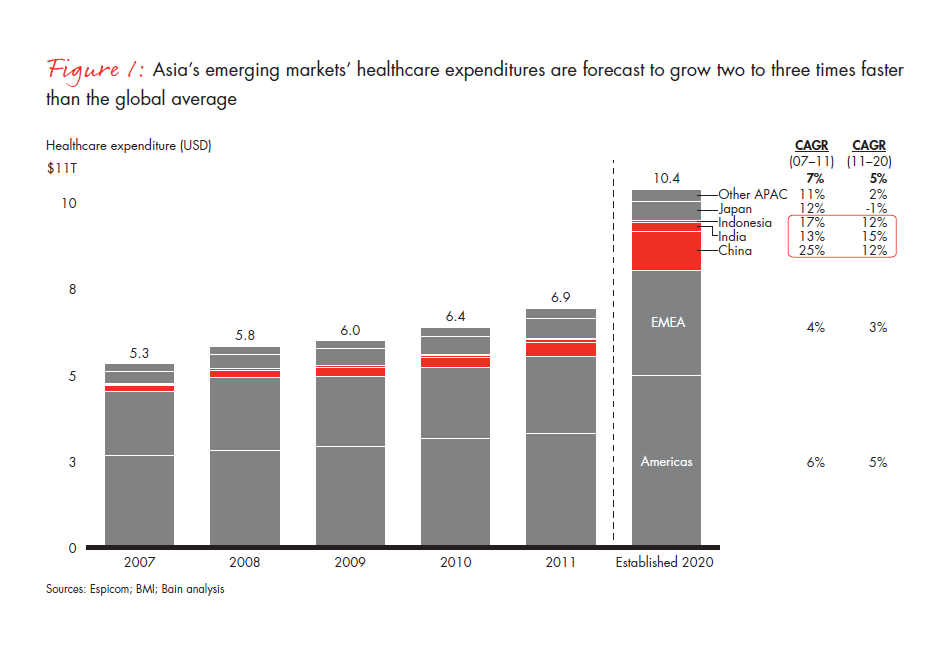
The combination of scale and economic growth makes Asia’s developing economies some of the hottest markets for pharmaceuticals and medical devices.
Analysts expect global healthcare companies to see a disproportionate amount of their growth coming from developing markets. Forecasts for GlaxoSmithKline, for example, project the company’s pharmaceutical sales in Asia to increase six times its global rate. Asia sales of Medtronic’s medical devices will grow an annual 11% between 2011 and 2015, according to some estimates— far surpassing its 3% global sales average.
Capturing this growth requires new business models that can be difficult and expensive for multinationals to build. For example, the biggest opportunities in medical devices lie in the market for “good enough” products—the mid-market segment of reliable, low-cost products that are priced significantly below multinationals’ premium offerings (see Figure 2). The trouble is, producing good-enough products and deploying the leaner go-to-market models that are required to support them run counter to the corporate DNA of most multinationals. In developed and developing markets alike, most multinationals have built their businesses and reputations exclusively on the premium market segment. Many that have tried to shift gears have found themselves faced with multiyear investments that failed to produce the desired results. These failed efforts have further reinforced multinationals’ instincts to exclusively maintain premium offerings, even while they watch value competitors gain share. In cardiac stents, for example, Johnson & Johnson created the market in China and witnessed new local value entrants grab more than 60% of the market in just three years after the product’s initial launch. Ultimately, Johnson & Johnson exited the business.
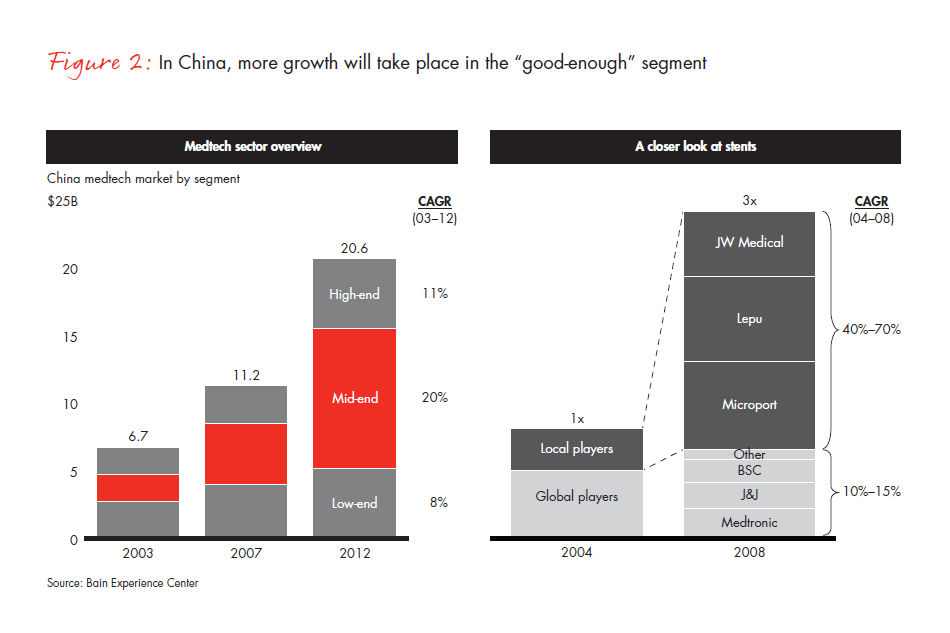
Whether it’s medical devices, pharmaceuticals or healthcare services, growing in Asia’s emerging markets requires a broad distribution network and an ecosystem that includes regulators and other public relationships. For companies pursuing organic growth, these channels are challenging to develop quickly and efficiently enough to compete. Multinationals also need a host of special capabilities, everything from local teams with deep market knowledge to lean and nimble operating structures. These, too, are tough to build organically. The challenges intensify with rising demands by corporate headquarters for deeper budget cuts alongside escalating demands for growth.
Tricky business in Asia
Enter M&A. To quickly fill the gaps, multinationals increasingly turn to acquisitions. Healthcare M&A activity in the region is healthy, with pharmaceutical companies leading the pack in the number of transactions. But M&A is tricky business in Asia, where so many companies get tripped up, particularly when it comes to performing diligence on targets and effectively integrating and executing after the deal closes. The challenge is amplified by another factor: The shortage of available assets has delivered inflated valuations. Given high valuations, acquirers need a strategic logic that looks further into the future than the traditional near-term return on investment (ROI) of developed-world transactions. Beyond the high cost and shortage of assets, there are other significant challenges in Asia: High volatility from sociopolitical uncertainty and rapid policy changes, fragmented regional markets, diverse local competition, and justified concerns over quality and compliance all bring uncertainty into each and every transaction.
It’s no surprise, then, that many healthcare companies find it difficult to get M&A right, as crucial as it is for growth. The healthcare industry is littered with more than its share of ill-fated deals. But despite troubled deals, recent Bain & Company analysis of corporate deal activity—both within and outside of healthcare, over the last 11 years—has found that M&A as a growth strategy has been quite successful, and businesses that do this well grow more shareholder value than those that don’t (see Figure 3). Furthermore, deal makers that were frequent acquirers—investing in multiple deals over time—and followed a disciplined, repeatable model came out the biggest winners. A company that does more acquisitions is likely to identify the right targets more often, develop the capabilities required to vet deals and build the organizational muscles to be more effective at integrating acquisitions. That experience is reflected in the data. As a group, companies across the globe that engaged in occasional M&A activity averaged 4.8% total shareholder returns (TSR), compared with 3.3% for those that were inactive. Yet, the most active companies in our study reported a TSR of 6.4%—almost double that of their inactive counterparts.
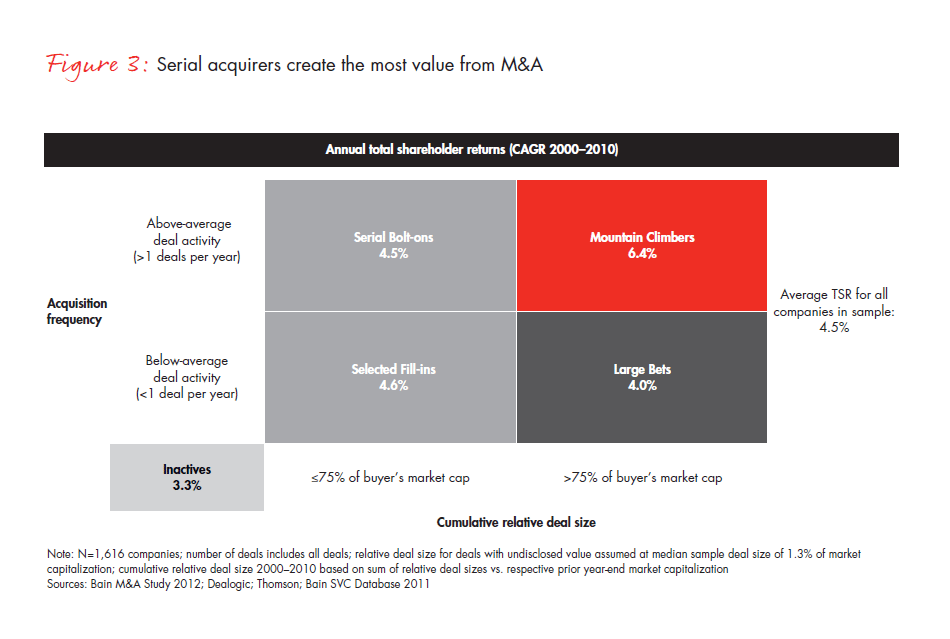
Our analysis strongly suggests that executives will need to focus even more on M&A to meet the growth expectations of their investors. The big trick in Asia is to adapt M&A strategy to the market’s unique conditions—and the nuances of every country and sector. Our experience and analysis also show that a portfolio management approach delivers the best results. This is particularly true in regions where scale deals are few in number (see Figure 4). In China, for example, only six local medtech companies have revenues in excess of $200 million. Portfolio management involves creating something akin to a mutual fund of assets— placing well-considered multiple bets that create a strategic platform for growth. Based on our experience with healthcare clients in emerging Asia, we’ve identified the five key questions companies must ask and answer to successfully execute an M&A strategy (see Figure 5).
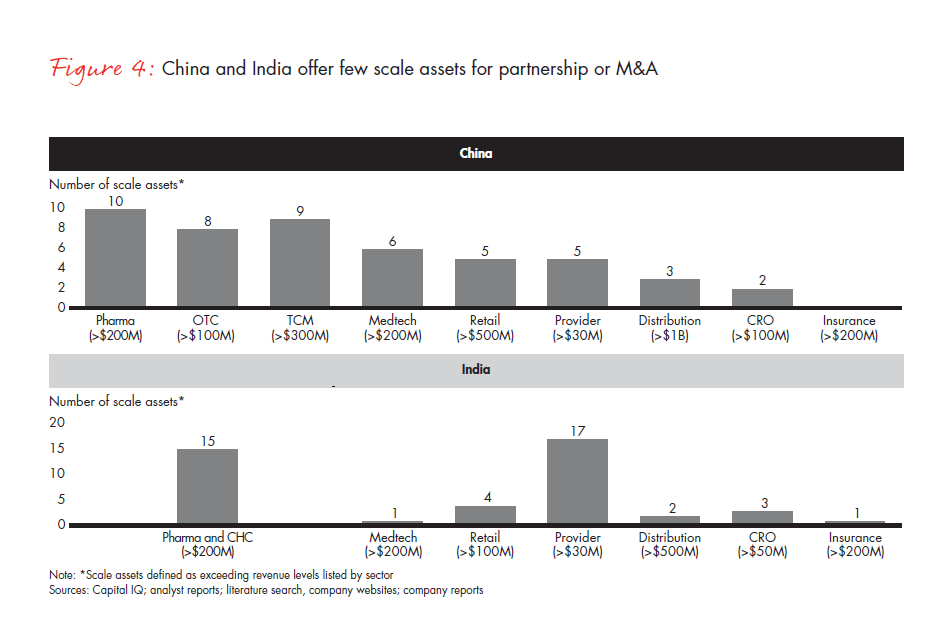
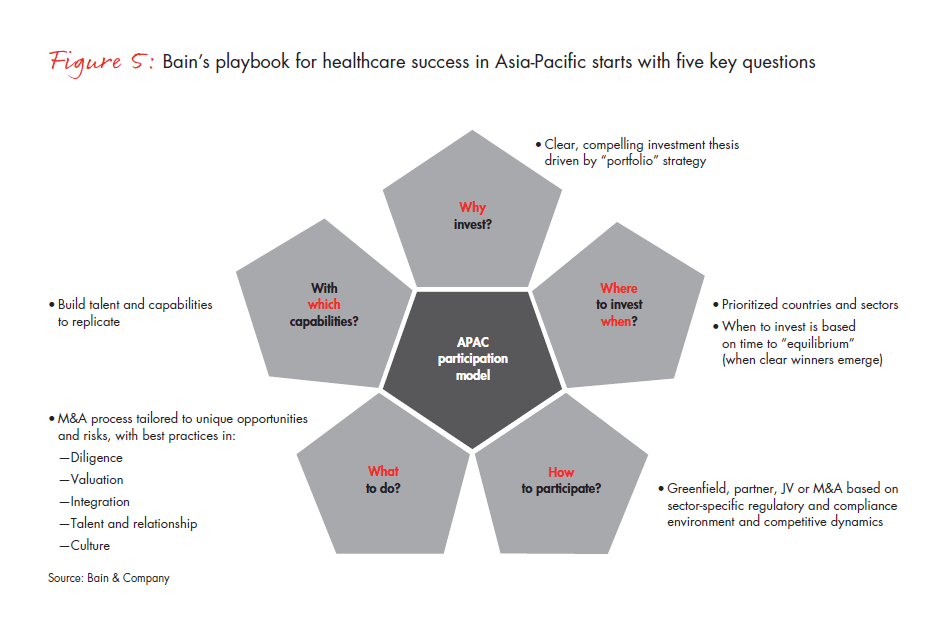
Why invest?
Whether it’s an acquisition, joint venture or strategic partnership, a company must know the compelling reason behind the deal. Companies look to their unique needs and investment horizons to help them define their portfolio strategies. Beyond the conventional wisdom of near-term ROI, a portfolio strategy should consider the potential for improving market position and growing share alongside the risks and opportunities for the company’s core business over the long term. It should also take into account the capabilities and access offered, as well as the possibility of gaining an early-mover advantage. Also important: the longer-term opportunities to export out of the region, back into the developed markets. By overemphasizing deal valuation or price, companies risk participating in too few deals and potentially finding themselves relegated to the role of a niche player, even in their core markets. Portfolio returns should trump the returns of individual assets. The goal is to create a sustainable leadership position and profitable growth in a local market, with options for reverse innovation and eventual growth at home in the evolving developed markets.
Where to invest and when?
Companies need to diversify across asset classes, creating a balanced portfolio by taking multiple bets across countries, sectors and steps in the value chains. Abbott’s 2010 acquisition of Solvay Pharmaceuticals allowed the company to expand its product range in the good-enough segment. Sanofi’s 2011 purchase of Universal Medicare strengthened the company’s position in the mass segment.
Typically, two dimensions govern the where-and-when decision (see Figure 6). First, acquirers should consider a country’s potential for scale, growth, profitability and influence on external markets. Second, they should evaluate a country’s viability—everything from the government’s openness to multinationals, to exposure to compliance risks, to such infrastructure issues as the number of hospital beds per capita. Balancing potential and viability, China and India surface as the clear leaders among Asia-Pacific markets.
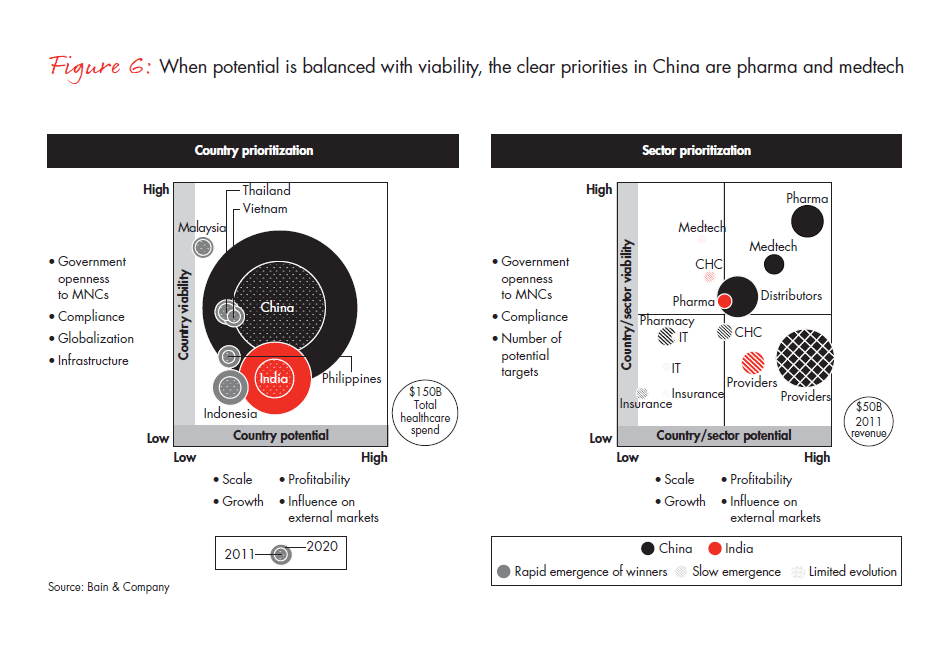
But within any given country, there’s wide variability in potential across categories. Take China’s pharmaceutical distribution sector. The market is highly fragmented and impacted by government policies that favor locals in the roll up of preferred assets. The result: Few multinationals are participating. For example, both McKesson and AmerisourceBergen have shied away. By comparison, the orthopedics implant sector is increasingly characterized by rapid consolidation, reforms, reimbursement and market dynamics that favor the combination of scale value players alongside premium multinational technology and brands. As a result, two top local players, Kanghui and Trauson, were recently acquired by multinationals Medtronic and Stryker, respectively.
Finally, timing is critical. Key questions for any sector are, when will the value segment develop? when will clear winners emerge? and when must I act? To find answers, most successful companies systematically evaluate a host of factors across their markets, from therapeutic pathways, to entry barriers, to local and regional market diversity, to competitive maturity and capability fit.
How to participate?
As they build their asset portfolios, winning healthcare companies create a balanced mix of M&A, joint ventures, partnerships and greenfield investments. Choosing the right format means carefully weighing regulatory and competitive dynamics. For example, in the pharmaceutical and medtech sectors, China’s regulatory and compliance requirements, combined with industry dynamics, make M&A the strongest option. For multinationals interested in acquiring hospitals in India, regulations, target availability and competitive dynamics are suitable to M&A and joint ventures.
What to do?
The challenges of doing business in emerging markets are well known. The lack of financial transparency makes due diligence difficult. Valuations are often inflated. Integration is complicated. Talent is scarce, and cultural gaps persist across countries. But winning healthcare companies have developed ways to compensate. They adjust for high valuations by focusing on long-term strategic value beyond ROI and accept longer paybacks. They take a go-slow, judicious approach to integration, particularly in customer-facing functions. They keep talent and key personnel with incentive plans and elevated positions, and they nail down those critical details before the deal closes. When Philips bought Shenzhen Goldway, for example, it offered retention packages to line managers along with long-term service awards. Most important, it positioned the Goldway leadership at the top of a new business unit, thus retaining the relationships and steerage that were at the root of the company’s success.
Consider due diligence. Before PerkinElmer purchased Sym-Bio, it embarked on a diligence process that was tailored to the local market. It relied heavily on primary research performed in parallel by professional firms and internal line experts. In addition to the business model and company financials, it assessed the management, intellectual property, environmental and legal risks of pursuing the deal. All of this was enabled by “reach around” diligence—the company reached out to market constituencies, including competitors, customers and suppliers, to bolster information that was available from the company.
As they build their asset portfolios, winning healthcare companies create a balanced mix of M&A, joint ventures, partnerships and greenfield investments.
Successful acquirers take a similarly cautious approach to integration, often using a wait-and-see model. Philips only integrated with Shenzhen Goldway where it mattered most during the first three years—in areas such as distributor management—and then performed a full integration afterward as traction, capabilities and understanding permitted. The thoughtful, low-and-slow approach to integration was critical to the deal’s success. By providing financial support and cash incentives, Philips was able to retain nearly all of Goldway’s distributors. It even managed channel risk with a comprehensive compliance program, which included distributor background checks deployed in such a way as to not lose traction in the market.
And then there are the inevitable cultural gaps. Bain research found there was a huge difference between deals that proactively identified cultural issues in due diligence and addressed them in integration, and those that did not, regardless of the complexity of cultural issues. A proactive approach netted above 5% higher stock price performance compared to sector indices, versus a more than negative 4% share-price underperformance in deals that failed to identify and negotiate cultural hurdles. It’s hard to overstate the importance of having a capable team on the ground to bridge the gap between the two merging entities.
With which capabilities?
Most successful companies develop Repeatable Models®— unique, focused sets of skills and capabilities that they can apply to new products and new markets over and over. Our own analysis and experience confirm the power of repeatability in the world of M&A. An acquirer’s expertise in finding, analyzing and executing the transaction, and then in integrating the two companies when the deal is done, determines the success of the typical deal. Frequent acquirers create a repeatable M&A model, one that they return to again and again to launch and negotiate a successful deal.
What are the skills and capabilities for a successful repeatable M&A model? The best companies build a dedicated core M&A team with rich transactional and integration experience. They involve product-line staff early on and make them accountable for long-term results. They set clear M&A policy and target assessment criteria, institutionalizing the deal-making process with clear roles and responsibilities. They create a new playbook for integration that includes compliance and quality standards and is distinct from the one they use in developed markets.
Building a healthcare business in emerging Asia means looking to M&A, joint ventures and other deals that will help a company gain traction. But the difference between success and failure rests on tailoring the approach to the unique characteristics of Asia’s diverse markets—using these five basic questions to create a high-return mutual fund of assets.
Matthew Collier is a Bain & Company partner based in Shanghai and a member of the firm’s Global Healthcare practice. Grace Shieh is a Bain principal based in Shanghai.





